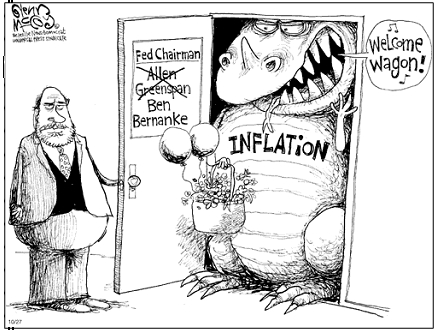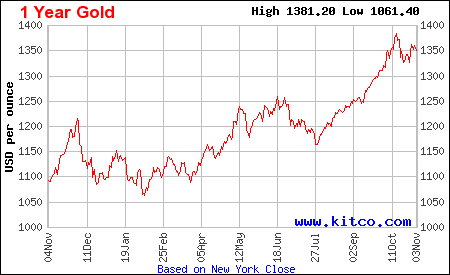11.04.2010
07.16.2012 replaced broken link

Uncle Ben, Inflation is Already Here
original article written by Net Advisor™
With the American public generally against adding more to the deficit via stimulus spending, the Obama Administration may have influenced the FED in getting the FED to add more stimulus anyway.
The FED is reportedly going to buy some $600 Billion of U.S. Treasuries over the next 6-7 months at the rate of about $75 Billion per month on top of $35 Billion more per month from maturing mortgage bonds (Source: Wall Street Journal).
What people may not know is to ask the following question:
Where is the FED getting $600 Billion?
Answer: Most of the cash is being funded by just printing more dollars.
The intended move by the FED is to lower interest rates beyond their already record low rates. The FED seems to think that deflation is a risk, and by purchasing more Treasuries that will help move away from deflation and into inflation (Source: Businessweek-Bloomberg PDF (read Bloomberg PDF with comments). This new stimulus thinking is that inflation will help jump-start the economy. This has been tried before and there is no free ride in economics.
What the FED may be overlooking is that inflation has been here for the last two years.
“Some commodities have been on a tear in recent months, and the Reuters/Jefferies CRB Index , a global commodity benchmark tracking 19 commodities that are mostly U.S. traded, is at a two-year high.”

- Gold prices are up 26% this year. Silver is at a two-year high.
- If you need gasoline for your car or heating oil for your house to keep you warm this winter, expect to pay a lot more and remember to thank the Obama stimulus and the FED’s stimulus for helping push oil prices from the March 2009 low of $33.87 to $86.41 a barrel on November 4, 2010. The result of this inflation is that oil prices are up 155% since March 2009.
- And if ones wears clothing, odds are it contains cotton, and clothing can cost more as cotton prices are up 52% just this year.
- If you need to eat, one will find that grain prices are up sharply. Wheat prices up 29% in 2010. Oats and corn used in everything from human food production to chicken and cow feed are also up 36% and 37% respectively.
- Nickel, used in consumer products such stainless steel, magnets, rechargeable batteries; and industrial uses including nickel steels and nickel cast irons is up 32%.
- For those who need that cup of Java each day can expect to pay more as coffee prices are up 38% in 2010.
- Palladium, an industrial metal is up 47%.
All of this on the back where the FED is concerned about deflation, not inflation.
Someone needs to tell the FED, “inflation is not only here, it has been here for the last 2 years, and it is not slowing down.”
The FED’s new $600 Billion stimulus move will have other implications that most people probably don’t know about, or that we are not as likely to hear a high level broadcast on the TV news. As the FED buy treasuries, that lowers interest rates, but it also lowers the value of the U.S. Dollar.
If you get paid in dollars, or you have U.S. currency in your bank account, it has just become worth less than before this stimulus.
— Net Advisor™
A lower U.S. Dollar helps U.S. companies earn more money on overseas sales. The reason for this is that consumers in foreign countries can buy more U.S. made goods using less of their local currency. Unfortunately this does not help U.S. consumers. A lower U.S. Dollar makes imported goods to the USA more expensive because it takes more dollars to buy foreign made products.
The plus side for consumers, business and government is that decreased treasury prices drive interest rates lower. The benefit here is that generally people can buy things on borrowed money at a lower cost, or refinance loans at a lower cost. The problem here in my view is consumers don’t have a pent up desire to buy things; they want to earn more money or just have a job. The other issue is that interest rates are already at historical lows, and this current move by the FED is not going to make a major drop in rates in my view.
The stock market rallied in part on the 11-04-2010 news because lower rates have been historically bullish for stock prices. The end game is a concern. The U.S. government or the FED can’t continue to artificiality pump money into the economy forever. At some point when the party of free and cheap money is over, someone is going to have to pay it all back — with interest.
__________________________________________________________________________
short link to this article : https://www.netadvisor.org/?p=6105
07.16.2012 update: The original Bloomberg story in paragraph 6 was moved or deleted; (story was linked here). We looked in Bloomberg’s archive pages to re-link the missing article. As of 07-16-2012 the article does not appear to have been archived. We replaced the missing, broken, moved or deleted link with an original PDF file to reference the article in discussion.
Graphics copyright respective owner.
original content copyright © 2010 Net Advisor™, revised © 2012 Net Advisor.org® All Rights Reserved.
NetAdvisor.org® is a non-profit organization providing public education and analysis primarily on the U.S. financial markets, personal finance and analysis with a transparent look into U.S. public policy. We also perform and report on financial investigations to help protect the public interest. Read More.
__________________________________________________________________________

